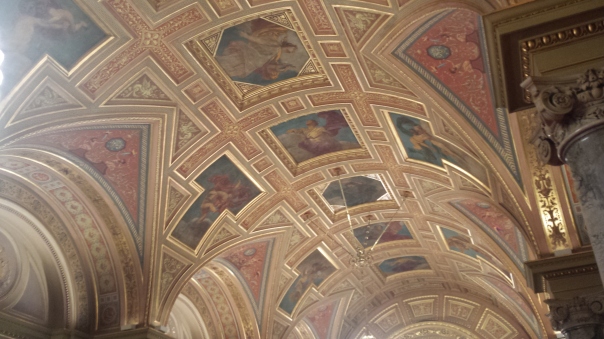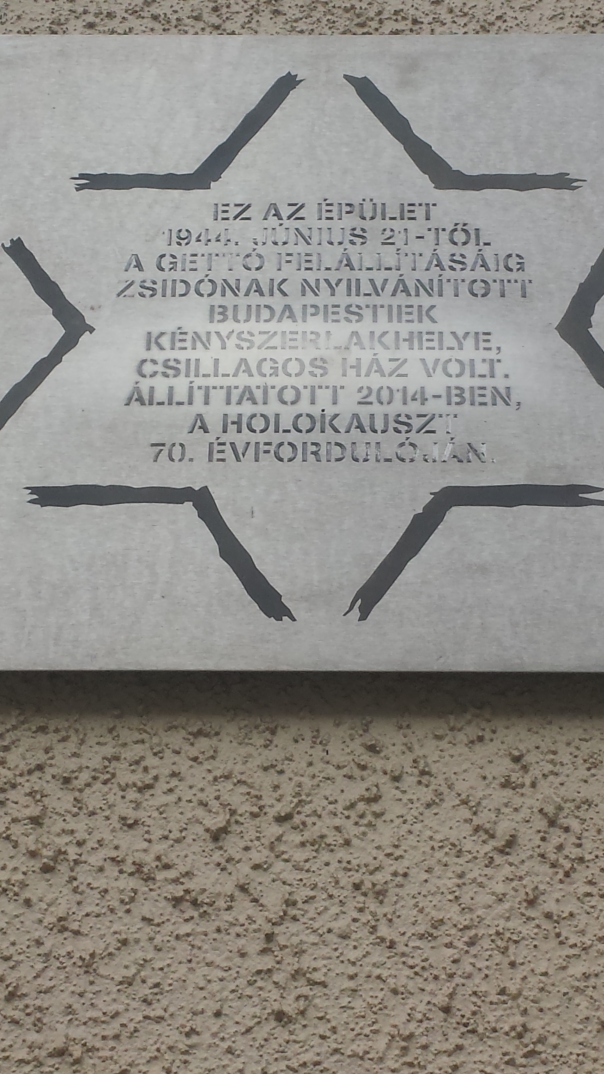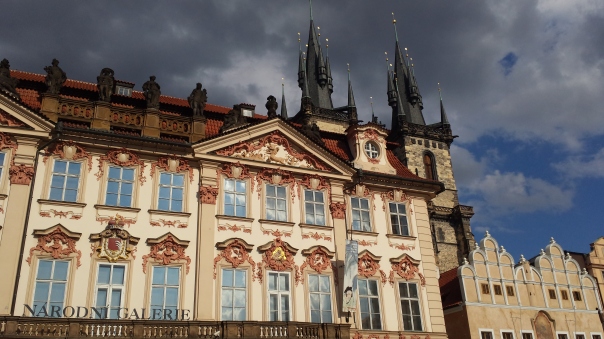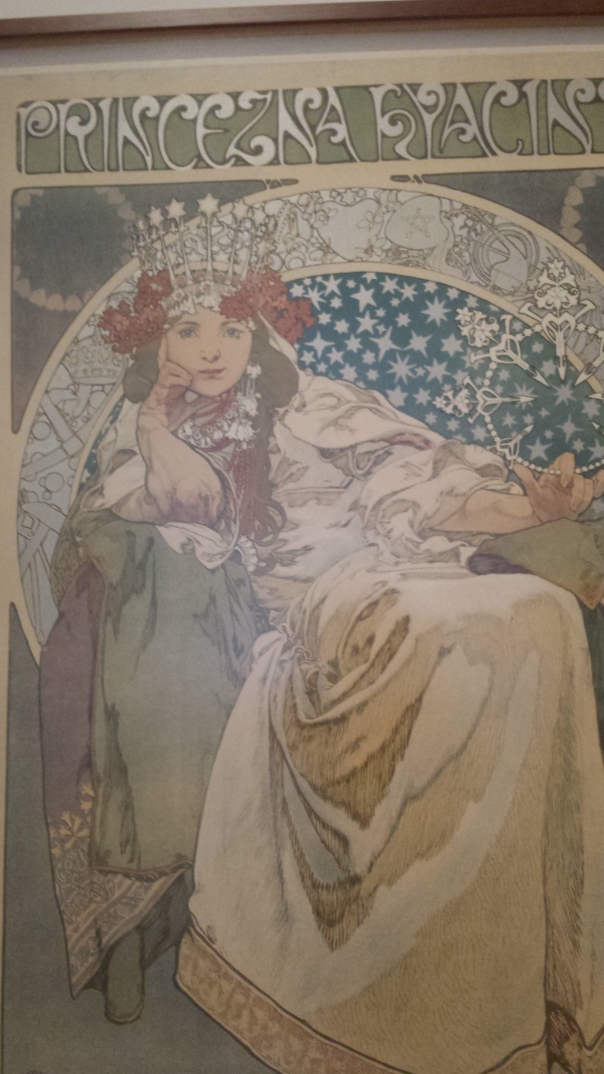(By Nina)
Kilmainham Gaol
Just before we left Dublin, we visited one of its iconic locations – Kilmainham Gaol (that’s “jail” for most of our readers). It was a site of British oppression and hangings for generations. The execution there of leaders of the failed 1916 Rising turned out to be a major British blunder, turning the rebels into national heroes, and ultimately leading to Irish independence.
Here’s a look down the hallway of the Gaol, and an element from the Gaol’s museum exhibit (a diary excerpt, though from a different prison):


The Festival
Because we really loved the traditional music festival we attended in Ireland two years ago (the Feakle Festival in County Clare), we built our itinerary in Ireland around attending another Irish Music Festival, called the “Cup o’ Tae” (as in “tea”) Festival, which was in County Donegal, in the town of Ardara. When we told Irish people where we were going, they seemed to have not heard of the town, but we eventually discovered we were mispronouncing it. It is “Ar-dra” (with the accent on the second syllable). We had been using three syllables, accenting the middle one. The Irish language is impossible for non-speakers to pronounce from looking at the spelling. It is full of silent letters or letters that have a different sound than we are accustomed to. You have to get an Irish speaker to pronounce it for you.
The town was somewhat bigger than we expected, and our hotel was well situated right in the middle of town. We were delighted to discover that this hotel was one of the centers of the festival. The weather was really cold, rainy, and hailing the day we arrived, with bits of sunshine every 45 minutes or so, which is apparently pretty typical. The festival is named after a beloved local fiddler, John Gallagher. His ancestors, also fiddlers, made tea for local fairs many years ago, hence the name. The first night’s concert was dedicated to another fiddle player who had died recently, and the members of the organizing committee were introduced.
The more I learned, the more this festival reminded me of the festival I have worked on for the last 30 years – the Western Workers Labor Heritage Festival. It has a small volunteer organizing committee that had been working together for the 15 years that the festival has been in existence, and it seemed that many of the attendees came back every year.
There seemed to be between 100-150 people at the festival, with very, very few visitors from other countries. We met several people from Northern Ireland (Ardara is quite close to the border), a few from England, and all the rest from the Republic of Ireland, many with roots in the immediate area going back centuries. We became mini-celebrities as the people from San Francisco and Portland (our cousin MJ) and before long, as in Feakle, when we walked down the street, we received friendly greetings from many lovely folks. We even had a song dedicated to us at the final concert, by a musician who had had quite a bit of Guinness and for some reason thought we were from Minnesota, but remembered our names!
The photos interpersed with the text here don’t necessarily match the text, but are included to give a flavor of the overall event.

The focus of the festival was on fiddle and we heard some amazing musicians. I admired an instrument that looked like a lute. When I inquired about it, the musician said it was an Irish bouzouki, which is an Arabic instrument (which has become a traditional Irish instrument as well) with 4 sets of double strings. He explained to me that the Arabic bouzoukis had a curved back like a lute, but because many Irish men had large bellies, they made the backs of the instruments flat so the musicians could reach the strings. I’m not sure if he was kidding or not.

There was also a wonderful pipe band with about 5 sets of bagpipes, 3 drums, and a bunch of fiddles and banjos. It was made up primarily of multi-generations of members of 4 families and had been in existence for 44 years! The leader was the only woman piper I have ever seen. They played both in concert, and also in outdoor sessions on the street in the afternoon, when the weather cooperated.


During the outdoor sessions, you could find up to 3 different groups jamming within a one block radius in the center of town. Although the music was mostly Irish, once in a while music that had drifted back across the pond from the US would be played, including two absolutely amazing versions of the Orange Blossom Special and a few country western songs. Dan and I did a couple of well-received songs in the pubs. We also became friendly with a family with three boys, who played fiddle, drum, and accordion, and also danced. The father appeared to play everything!


The talent of the youth, many of whom were taking classes on their instruments at the festival, was just astounding. They were treated with so much affection and respect by the older musicians, it was lovely to see. At the final concert, several of the best young people, appearing to range in age from 10-14, performed.



The fiddler who was receiving special recognition this year at the festival was supposed to appear at the final concert. But he is a sheep farmer and received a call that afternoon that his sheep had broken through the fence and were escaping, so he had to leave.

Someone else who was supposed to perform also got sick, but the festival was so full of talented musicians that the organizers were quickly able to assemble an alternate line up. It all reminded me of the time at the Western Workers Festival that half of our performers got the flu the day of the final concert, and we were able to look around the room and go “you, you, you and you – you’re in the concert.” I had some really nice conversations with the Cup o’ Tae Festival organizers about the similar challenges we faced.
Note: Our blog doesn’t do videos, which is a real limitation in reporting on a music festival, but you can check out our Facebook pages to see short clips of the music (and other tidbits from our days in Ardara).
To Galway
The morning of May 2, we headed for Galway, passing, by chance, Yeats’s grave on the way.

 (Some other of our adventures along the way to Galway are included in the preceding blog entry, The Irish Art of Conversation.)
(Some other of our adventures along the way to Galway are included in the preceding blog entry, The Irish Art of Conversation.)
Galway is a beautiful city, with lots and lots of water. Our hotel looks out on the huge mouth of the Corrib River, which has wild swans swanning around. The river empties into Galway Bay, and we can see County Clare across the bay.
We are near a medieval structure called the Spanish Arch, which was part of the old city walls. We are a little overloaded with sightseeing towards the end of this long, wonderful trip, so have been enjoying mostly taking walks and nosing around town. This town is also foodie heaven and our favorite has been a beautiful little café in a medieval stone building recommended by my friend and colleague Conchita, who, along with her Irish in-laws, has provided us with some great travel tips.


Tonight (May 4), we had a delightful dinner at the home of someone we connected with through Servas, the international friendship group we belong to, and tomorrow we head off on the last leg of our trip before returning to Dublin to catch the flight home – the famous music town of Doolin, near the Cliffs of Moher. The weather is pretty wild and we are wearing all of our layers, but it is supposed to get up to 60 on Friday, when we go to the Cliffs and hopefully we won’t blow off! Hard to believe that this amazing trip is coming to a close, but we will enjoy returning to the lovely Bay Area and our family and friends.

























 (Some other of our adventures along the way to Galway are included in the preceding blog entry, The Irish Art of Conversation.)
(Some other of our adventures along the way to Galway are included in the preceding blog entry, The Irish Art of Conversation.)
















 One of the bands featured a Hungarian instrument that looks like a large hammer dulcimer. It sounded like a cross between a hammer dulcimer and a harpsichord.
One of the bands featured a Hungarian instrument that looks like a large hammer dulcimer. It sounded like a cross between a hammer dulcimer and a harpsichord.


















